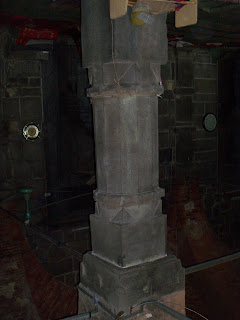This startlingly elegant work of pre Mughal architecture was built between 1558 and 1559, by one Sulaiman, evidently a high official at the court of one of the last of the Afghan Suri rulers.
An unusual six dome piece in design, it is even more unusual in construction. In a land substantially, almost completely, devoid of stone most structures are built of brick, and indeed the basic structure of Kusumba is brick.
What raises it from the average is its cladding of black basalt. And that stone is clearly recycled architectural stone from one, or more, of the many Buddhist Vihara that were plentiful in the area.
Close examination of surface decoration on the exterior reveals that neither insert panels of decoration, nor even the infilling of arches contrived in the construction, are balanced or matched. Even roseate decoration varies in size.
But the most compelling evidence comes from the decor of the pillars, both internal and external, in which the basalt is sculpted with ‘V’ shaped designs. Even a casual examination of such pillars in museums, or scattered across the sites of vihara, reveals identical decoration.
 |
| Exterior, Kusumba Mosque |
But the most compelling evidence comes from the decor of the pillars, both internal and external, in which the basalt is sculpted with ‘V’ shaped designs. Even a casual examination of such pillars in museums, or scattered across the sites of vihara, reveals identical decoration.
 |
| Pillar, Kusumba Mosque |
Internally, an unusual ‘gallery’ is also clearly constructed of reassembled interior work from a vihara, possibly even the surrounding of a frame Buddha statue. In fact, this may be the most substantial assembly of Buddhist architecture in Bangladesh.
The aggregation of sites from which such architectural, or sculptural material has been recovered in Northern Bangladesh is more than 50, so there were clearly, at the time, about 300 to 400 years after the devastation of the considerable Buddhist presence in the area during the Hindu rule, where Buddhism developed, even from the time of the Prince Gautama himself, many places from which such material could be salvaged.
A large heap of off cuts of basalt and marble rich rocks, together with substantial other architectural pieces, betrays the eventual carelessness of the considerably skilled builders in tidying up the site at the completion of their work.
The result is, certainly, one of the most attractive amongst the large number of very beautiful mosques in the country; made all the more appealing by the superb craftsmanship that made so much of the materials at hand. As far as we can tell, perhaps this mosque is the first such environmentally friendly piece of recycling in this environmentally vulnerable country!





No comments:
Post a Comment